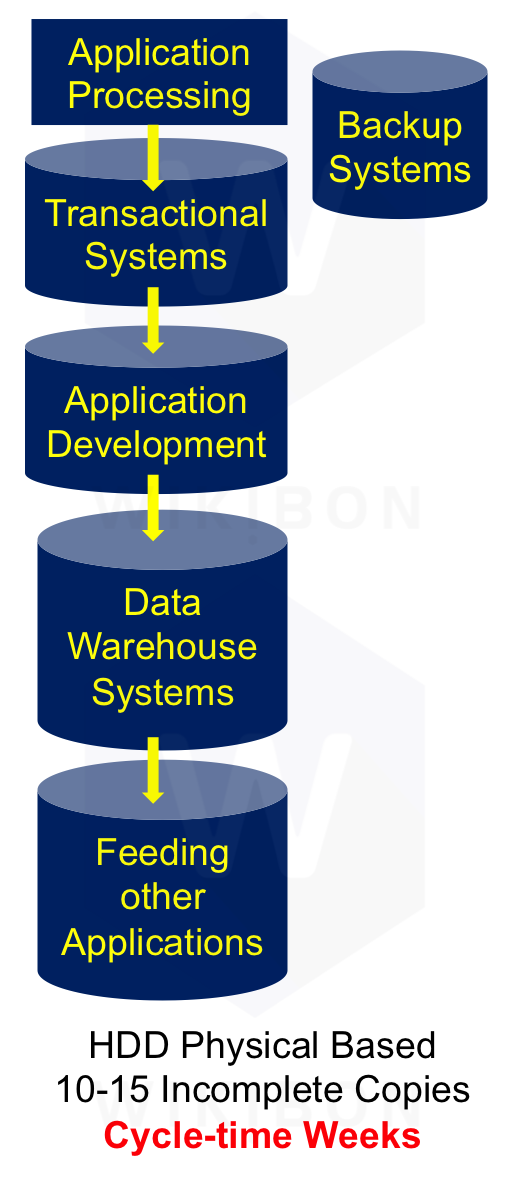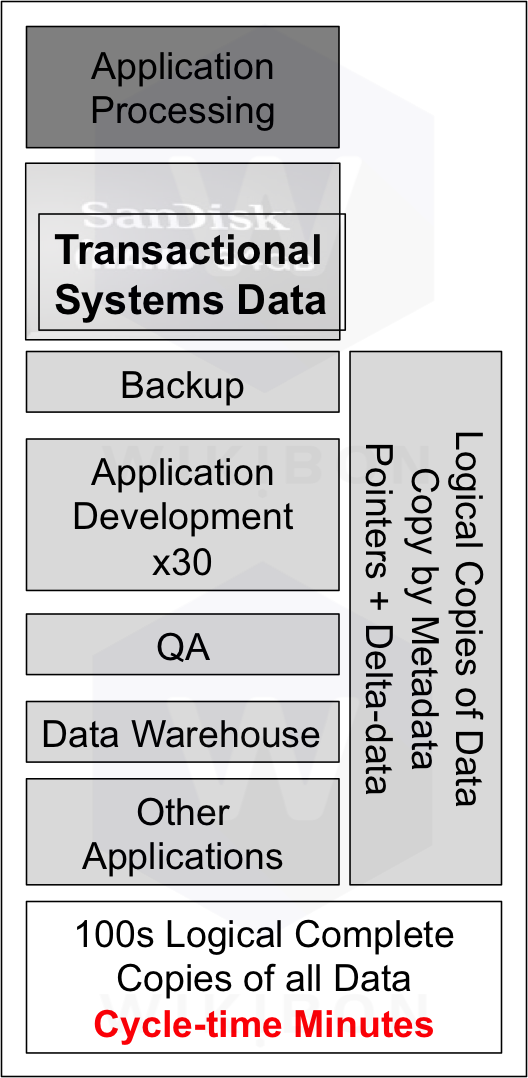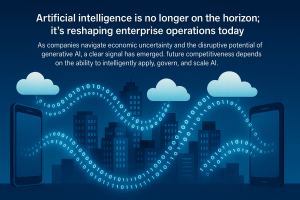Premise
IT executives should focus on the following five-step process to optimize the value from Oracle database licenses with an All-flash datacenter strategy:
- Reduce the number of Oracle Licenses required for current production;
- Use the all-flash infrastructure to scrub and share the latest logical copy of data & code with all application developers;
- Deploy the saved licenses to application development to speed development and deployment of new application functionality;
- Use the all-flash infrastructure to automatically and very quickly insert the latest key data into the data warehouse;
- Improve productivity of the Oracle application users by improving response times, utilizing near real-time data from the data warehouse, increasing the amount of data available to the user, and improving application functionality.
Figure 1 gives a executive summary of the results of the research when the 5-step strategy is applied to the Wikibon Standard Business model of a $1 billion revenue company with 4,000 staff and an IT budget of $40 million.
The net investment is $3.8 million, with an impact on the IT budget of $0.75 million in year 1. The NPV of the project is $53.2 million, with an IRR of 254% and a breakeven of 9 months. The major benefits are the improvements to end-user productivity from faster response times and greater application functionality.

Source: © Wikibon 2015
The assumptions and calculations of the analysis in Figure 1 are shown in Table 1 below.
Most Enterprise Oracle will continue to Run in Private Clouds
The Oracle database is the most feature-rich operational database in enterprise computing. The application departments of many enterprises have chosen Oracle as their development platform, and the operational platform for in-house applications and package applications.
There is increased focus on database development in recent years. Traditional competitors such as IBM’s DB2 have focused on advanced features for big data and analytics. Microsoft’s SQL server is often a choice for applications needing less functionality than Oracle. There are open source versions of MySQL (MarieDB, Oracle MySQL, Percona and many others), which are much lower cost but not as functional or as stable. In addition, there are many specialized databases, both NoSQL and SQL, that have recently attracted funding. Aerospike, Couchbase, Hbase, Gemfire, Greenplum, SAP HANA, are just to name a few. To date, there is no alternative database to Oracle that provides the same functionality and availability for core enterprise applications, the Systems of Record.
Cloud Infrastructure-as-a-Service offerings are growing very fast, and AWS fastest of all. AWS provides many databases as a service. Perhaps the most interesting is the MySQL fork called Aurora, which is being positioned by AWS to provide a long-term alternative to Oracle. Missing from AWS is a fully-featured Oracle database as a service offering, although there is a limited Oracle database service that can be used for development and small Oracle applications.
Without an effective Oracle database as a service offering, AWS recommends conversion to Aurora for Oracle shops. AWS is providing conversion tools to convert Oracle to Aurora. There are many small Oracle “edge” applications that can and should be converted to Aurora or other lower cost databases.
However, conversion of core applications from Oracle to other databases is an expensive and extremely risky enterprise strategy, with the potential to endanger the survival of companies. Until the development of fully functional and cost-effective Oracle clouds, or a viable alternative offering to Oracle database, the majority of Oracle core systems will continue to run in private clouds.
The bottom line: Until there is a viable alternative offering, Oracle is and will remain a mainstay of enterprise core computing for many organizations. Although some Oracle applications will migrate to public clouds, the majority of Oracle core Systems of Record will continue to run in private clouds.
Oracle Licenses are more Expensive than the Infrastructure they run on
Oracle is licensed on a per processor core basis. The cost for a one core Oracle license is over $45,000/core for the Enterprise Edition. Features such as Oracle RAC, data guard and others are additional license costs per core. Oracle offers new licenses initially free with enterprise licenses, but only until the next review. Oracle offer good discounts related to enterprise licenses of about 50% for initial purchasing, but the discounts dry up if the license revenues to Oracle start falling. Oracle charges about 22% of the list price for maintenance support. The Oracle database licenses and maintenance are many time the cost of the infrastructure to drive the database.
Bottom Line: For Oracle environments, the infrastructure should be designed to optimize the utilization of the Oracle licenses in a Private Cloud, and the business value generated from those licenses. This research recommends five steps to achieve this objective.
Step 1: Reduce the number of Oracle Licenses required for Current Production
As Oracle is licensed by the processor core, the number of cores need to be reduced to run production Oracle more efficiently. The ways to achieve this are:
- Focus Oracle processing on dedicated Oracle Servers. Creating a virtualized Oracle environment is an effective (but not the only) way of achieving this, with VMware being the leading enterprise option.
- Utilize processors with fewer cores, higher performance and with very large DRAM memories. Obvious, isn’t it! Put the newest servers into the Oracle pool and rotate the previous generation.
- High latency and especially inconsistent latencies are the biggest challenges to production database management. Any storage system with any type of magnetic disk drive is going to produce high and inconsistent latencies. Caches in DRAM help, but caches in traditional storage arrays actually make the situation worse for complex databases. Having just one IO in 200 with a 100 millisecond response time can introduce a hotspot in a full-function Oracle environment. The reason, is most IO in almost all databases is dependent on other IOs, and a chain of IOs is only as strong as its weakest link. The solution is to all-flash as the storage, eliminate hotspots, and radically simplify the storage support costs for DBAs and storage administrators.
- The flash storage media should, of course, be fast and be highly consistent, with good support for virtualized environments.
Bottom line: the additional cost of fast processors, increased memory and all-flash storage will be much, much lower that the cost of the 30% of Oracle production licenses saved.
Step 2: Use the all-flash infrastructure to scrub and share the latest logical copy of data & code with all application developers
Figure 2 shows the traditional workflow with magnetic disks (HDDs). Because of the severe limitation of HDDs, the same copy of data is very difficult to share. Snapshots can be made of HDD data (for example to provide a consistent recovery point). But sharing the data with developers or other application users is not possible becase of the low number of IOPS each individual disk can support. Data on disk optimized for one use (e.g., production) is not able to be shared with Application Development (AD), data warehousing or other applications. The result is multiple copies of the same data within the data center. About 10-15 copies is the number found in a typical data center, and it can be much higher. These copies (clones) usually have to be made at night or weekends, so as not to interfere with production. The copies (especially for application developers) are incomplete copies of the production data, usually weeks later.
Figure 3 shows the same data workflows in an all-flash datacenter environment. The same data can be shared across all the different uses of the data, because the underlying flash technology can handle hundreds of thousands of IOs, instead of the just 100 or 200 IOs that a single HDD can manage.
The logical copies are made by creating a consistent snapshot of the data. The logical copies of data are managed by metadata, held in DRAM. The metadata holds the pointers to the data and the delta-data from updates. The shared data can retain any de-duplication or compression across all the copies. Ideally, a quality of service (QoS) function can be used to ensure that the proper priority is given to the business users sharing the data that produce the most business value.
A practical example of an all-flash environment that illustrates almost all of the functionality above is the EMC XtremIO all-flash array. The data is de-duplicated and compressed, the scale-out architecture supports an efficient DRAM pointer system for logical data sharing across all the nodes, and the consistent snapshot functions are very efficient. The IO response times are consistent at less than 1 millisecond.
Because the IO rates of flash are thousands of time greater than HDDs, there is little likelihood in practice that data sharing will lead to any contention for IO resources. However, the simplest way to guarantee that there is no contention is to provide a quality-of-service (QoS) function for all the user groups. The QoS features are not yet available on XtremIO, but understood to be coming in 2016.
Other features important to DBAs in Oracle XtremIO environments are Oracle Enterprise Manager (OEM) plug-in APIs for consistent snapshots, and similar capabilities for SAP/LVM Landscape Virtual Manager. Another recent valuable addition for DBAs is AppSync, which provides them with self-service data protection for XtremIO together with self-service setting of SLAs. Previous Wikibon DBA productivity research shows how DBAs can be up to 50% more productive taking advantage of functionality in storage vs. in the database alone.
As Wikibon research has shown before, scale-out architecture supporting a large number of nodes is of particular importance for implementing data sharing, as the metadata needs to be shared across all the nodes. Otherwise the data has to be copied from one array to another, defeating the major advantage of shared data, and increasing cost. The only scale-out all-flash array implementations are EMC’s XtremIO, Kaminario, HP’s 3PAR array, Oracle FS1 (16-node announced, GA not yet committed) and Solidfire. Flash arrays built from the traditional two-controller architecture are very unlikely to scale to enable significant data sharing except in some small enterprises.
The first use of this shared data should be to provide up to date full logical copies of the data for all application developers and DBAs supporting the Oracle applications. In minutes, not weeks.
Bottom line: Data sharing is more than de-duplication. Scale-out architecture maximize data sharing and minimizes cost. By using a scale-out all-flash architecture with shared metadata, all Oracle application developers can receive the latest version of production databases and code in minutes, not weeks.
Step 3: Deploy the saved licenses to application development to speed new application functionality
The impact of providing an all-flash storage environment with up-to-date versions of the data is profound. Previous Wikibon research has shown the productivity and quality improvement from this approach. These include:
- Ability to implement a Dev/Ops environment for Oracle
- Ability to spin up virtual machine clones very rapidly
- Every time there is a code change, provide the ability for automatic regression testing the environment straight away, instead of waiting for QA.
- Ability to delete/tear down virtual machine environment automatically
Scale-out all-flash arrays have the ability to support this functionality in practice, and provide very rapid turnaround of normal development processes such as compiles.
The practical feedback from early adopters of these techniques show profound improvements. The improvement in application developer productivity has been 2x or more. The reduction in elapsed time for projects has been about 50%, half the time. In one early installation, the percentage of code failing QA went from 17% to 2%, because the application developers were able to fully test the code with complete databases with all the latest changes.
The impact on Oracle productivity also means that the maintenance work is getting done in half the time. In a typical environment, 80% of AD work is maintenance, 20% is new work. By reducing the amount time spent on maintenance to 40%, the amount of time available for new development has increased by a factor of three (3), from 20% to 60%. The amount of code that can be produced by these developers has improve by a factor of two (2). The amount of new functionality that can be given to improve end-user productivity (internal or external) has now been increased by a factor of six (3 x 2 = 6).
The practical impact of this productivity is that the amount of processor time used by developers also increases, even after the saving is CPU IO wait time. The increase in CPU time means that more Oracle licenses are required for use by the developers.
Bottom line: Take the 30% of Oracle licenses saved in production and move them to support the Oracle application developers. This will support an increase of 6 times the amount of new application functionality to improve end-user productivity.
Step 4: Use the all-flash infrastructure to automatically and very quickly insert the latest key data into the data warehouse
Figure 2 above shows how data has to be copied in the long ETL processes required to move the data to the data warehouse. This means that the reports coming from the data warehouse are in essence days or usually weeks out of date. For many business processes this is a not acceptable, and the business view of the data warehouse value is poor. There is significant effort in providing much quicker solutions with in-memory databases, to provide much faster reports and analysis to the business.
Another complementary and much simpler approach, which utilizes the existing data warehouse infrastructure, is to focus on key data requirements from the production systems that are needed in real-time or near real-time. Data warehouses in general focus on a columnar view of data rather than the row view of data for operational systems. All-flash storage enables the ability to share real-time Oracle table information in the production systems, snapshot them, and access them from within the data warehouse. Using flash allows columnar-based extracts and reports to be completed very rapidly without reloading of the database.
Bottom line: An all-flash Oracle strategy allows key production data to be available to the business within the existing data warehouse in minutes, instead of the days/weeks of the full ETL process.
Step 5: Improve productivity of the Oracle application users by improving response times, increasing the amount of data available to the user, utilizing near real-time data from the data warehouse and improving application functionality
Flash increases the amount of data that is available to application. Most Oracle (or any database) application has to be constrained on the number of database calls. If there are too many DB calls, the Oracle locking rate increases and the performance and availability characteristics of the application become unstable and expensive to maintain operationally and developmentally. The all-flash datacenter allows the number of database calls to be radically increased, and with it the functionality of the application is improved. The end-users need less interactions to achieve the same objectives.
Wikibon compilation of research on response time productivity is shown Figure 3. The use of faster processors and faster storage to improve end-user response time is a simple way to improve productivity for existing applications. The optimism strategy would be a combination of better response time and additional functionality as discussed above.

Source: © Wikibon 2015
Bottom line: An all-flash Oracle strategy will allow Oracle applications to have better end-user response times, increased functionality from increased data availability and six times the application development resources for implementation. The expectation is that the productivity of the end-users will be doubled while they are using the new applications.
The Business Case for Optimizing the Value of Oracle Licenses
Table 1 shows the details of the financial analysis.

Source: © Wikibon 2015
Figure 5 shows the cumulative cash flow for the 5-step plan, and the financial metrics of the investment. The initial investment is $3.0 million, with an impact on the IT budget of $0.75 million in year 1. The NPV of the project is $53.2 million, with an IRR of 254% and a breakeven of 9 months. The major benefits are the improvements to end-user productivity from faster response times and greater application functionality.

Source: © Wikibon 2015
Conclusions
The Wikibon research shows that maximizing application value and optimizing the use of Oracle licenses are the most important metrics to deciding Oracle operation and development strategy. It also illustrates that new technologies such as all-flash storage can completely change best practice norms for achieving those metrics. The idea of sharing copies of data across multiple workloads is completely foreign to the existing generation of storage executives and administrators. They are used to copying data physically from HDD to HHD. In contrast, data sharing is rapidly accepted by the early adopters of all-flash data centers.
By applying the 5-step process outlined in the Premise above, and detailed in the sections below, significant business value can be driven. The case study of applying this 5-step strategy to the Wikibon Standard Business company shows a net investment of $3.8 million, with an impact on the IT budget of $0.75 million in year 1. This investment gives a net present value for the project of $53.2 million, with an IRR of 254% and a breakeven of 9 months. The major benefits are the improvements to end-user productivity from faster response times and greater application functionality.
The key to achieving these savings is to reduce the number of licenses required for the operations with all-flash storage, and re-utilize the saved licenses in Oracle application development to dramatically increase new functionality by a factor of six.
Action Item:
CIOs with significant Oracle investments should invest in an all-flash strategy, and use it to improve application response times, reduce the number of Oracle licenses required in production, move the Oracle licenses to application development, dramatically improve application development productivity, and improve the functionality of the Oracle applications at a much greater speed with the same resources.




